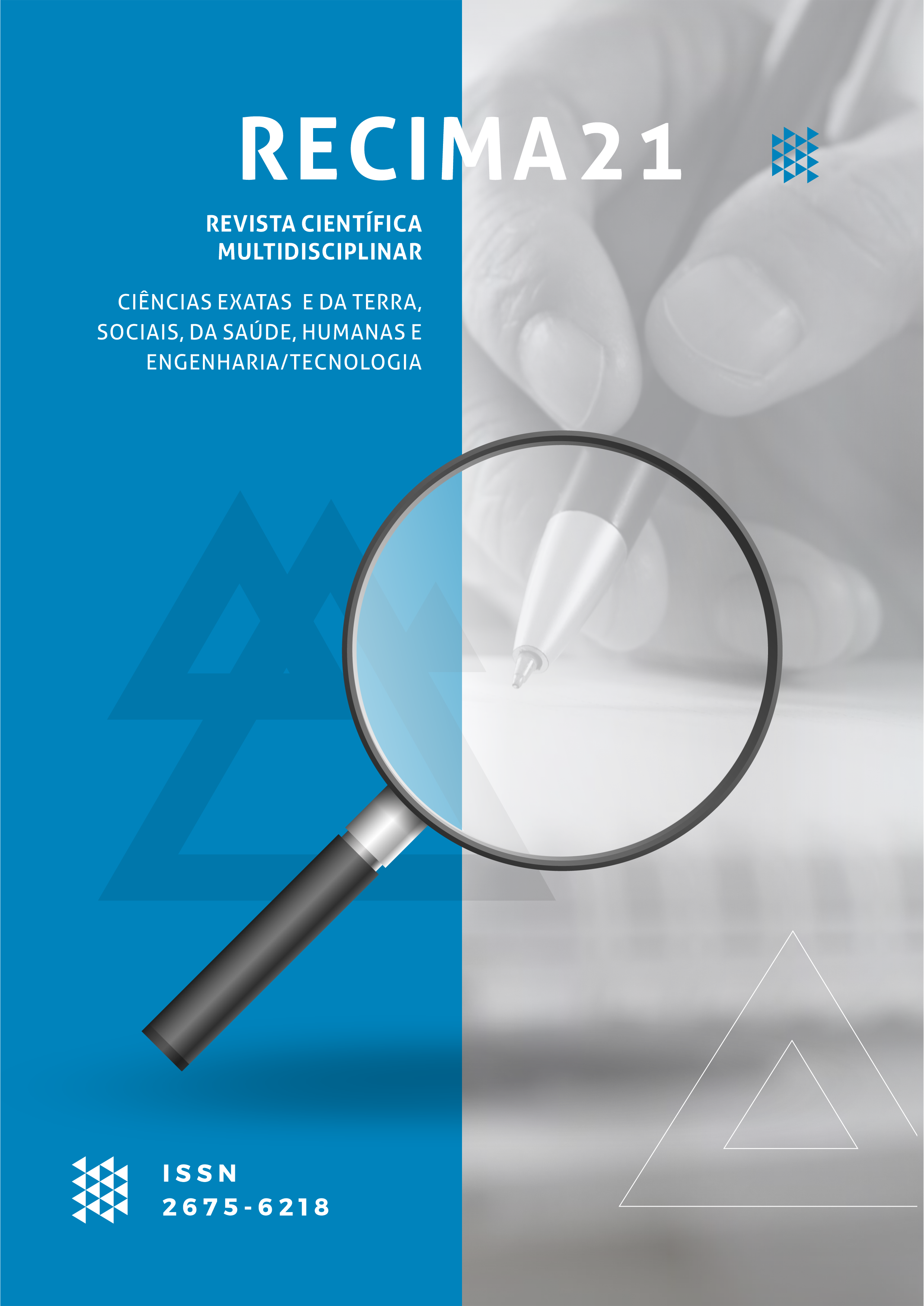TECHNIQUES FOR EARTHMOVING: STUDY IN A RESIDENTIAL SUBDIVISION IN THE CITY OF PAULÍNIA – SP
DOI:
https://doi.org/10.47820/recima21.v3i10.2042Keywords:
Earthworks, leveling, LoggingAbstract
Earthmoving is a complex process, and its execution depends on factors such as the size of the area, type of soil, its resistance in relation to its ability to withstand the necessary efforts, and the need for cleaning the area, which may extend the deadline for completion. The objective of this study is to demonstrate the earthmoving of a residential subdivision in the city of Paulínia - SP, Brazil. We sought to describe how the cleaning process took place and how the earthmoving is being implemented in the area. The methodology is a bibliographic review, and as a presentation method, the case study. The earthmoving is in progress, but it is already possible to describe the characteristics of the terrain and the needs for leveling the worked area, a fact that facilitated the earthmoving, not requiring major steps such as drainage, demolition or basic equipment for the execution of these operations.
Downloads
References
ALMEIDA, G. C. P. Caracterização física e classificação dos solos. Juiz de Fora: UFMG, 2005.
ASSOCIAÇÃO BRASILEIRA DE NORMAS TÉCNICAS – ABNT. NBR 6484:2020: Solo - Sondagem de simples reconhecimento com SPT — Método de ensaio. Rio de Janeiro: ABNT, 2020.
BAEK, H,; SEO, J. Optimized earthwork planning methodology for land development projects. In: INTERNATIONAL CONFERENCE ON COMPUTING IN CIVIL & BUILDING ENGINEERING - ICCCBE, 13., Nottingham, UK, 2011. [Proceeding…]. Nottingham, UK: University of Nottingham, 2011. Available: http://www.iaarc.org/publications/fulltext/P1-25.pdf Access: 9 May 2022.
BURDETT, R.; KOZAN, E.; KENLEY, R. Block models for improved earthwork allocation planning in linear infrastructure construction. Engineering Optimization, Berlin, v. 47, n. 3, p. 347-369, 2015. Available: https://eprints.qut.edu.au/65390/ Access: 9 May. 2022.
DEPARTAMENTO NACIONAL DE ESTRADAS DE RODAGEM [DNER]. Manual de implantação básica. 2 ed. Rio de janeiro: DNER, 1996
DIAS, T. F.; ANGNES, D. L.; WEGNER. D. O caso da terraplenagem Barbosa. E&G Economia e Gestão, Belo Horizonte, v. 16, n. 43, Abr./Jun. 2016. Disponível em: http://periodicos.pucminas.br/index.php/economiaegestao/article/view/P.1984-6606.2016v16n43p152 Acesso em: 9 maio 2022.
FARIA, J. A. Gestão de obras e segurança. Universidade do Porto, Faculdade de Engenharia, 2014. (Apostila do curso de Mestrado) Disponível em: https://web.fe.up.pt/~construc/go/docs_GO/sebenta/SebentaGOSE20132014pdfunico.pdf Acesso em: 8 maio 2022.
GALEGO, O.; MARCO, G. Terraplenagem na construção civil. RECIMA21 - Revista Científica Multidisciplinar, Maringá, PR, v.1,. n. 1, p. 1-12, 2021. Disponível em: https://doi.org/10.47820/recima21.v1i1.740 Acesso em: 16 abr. 2022.
GWAK, H.; SEO, J.; LEE, D. (2018). Optimal cut-fill pairing and sequencing method in earthwork operation. Automation in Construction, London, v. 87, 60-73, 2018. Available: https://doi.org/10.1016/j.autcon.2017.12.010 Access: 17 Apr. 2022.
HA, Q. P. ; .YEN, L.; BALAGUER, C. Robotic autonomous systems for earthmoving in military applications. Automation in Construction, London, v. 107, p.102934-102951, 2019. Available: https://doi.org/10.1016/j.autcon.2019.102934 Access: 17 Apr. 2022.
INOVAR, L. Terraplenagem e sua história. 21 abr. 2014. Disponível em: https://inovartopografia.com.br/terraplenagem-e-sua-historia/ Acesso em: 16 abr. 2022.
JASSIM, H. S.H.; KRANTZ, J..; LU, W.; OLOFSSON, T. A MODEL TO REDUCE earthmoving impacts. Journal of Civil Engineering and Management, New York, v. 26, n. 6, p. 490- 512, 2020. Available: http://dx.doi.org/10.3846/jcem.2020.12641Access: 17 Apr. 2022.
JI, Y., BORRMANN, A., RANK, E., SEIPP, F., AND RUZIKA, S. Mathematical modeling of earthwork optimization problems. In: INTERNATIONAL CONFERENCE ON COMPUTING IN CIVIL & BUILDING ENGINEERING - ICCCBE, 12., Nottingham, UK, 2010. [Proceeding…] Nottingham, UK: University of Nottingham, 2010. Available: http://www.andre-borrmann.de/docs/paper_Ji_ICCCBE2010.pdf Access: 9 May 2022.
KIM, B.; LEE, H.; PARK, H.; KIM, H. Estimation of greenhouse gas emissions from land-use changes due to road construction in the Republic of Korea. Journal of Construction Engineering and Management, New York, v. 139, n. 3. p. 339-346, 2012. https://doi.org/10.1061/(ASCE)CO.1943-7862.0000620
MARZOUK, M.; . MOSELHIM O. Multiobjective optimization of earthmoving operations. Journal of construction engineering and management, New York, v.130 , n. 1, p. 105-113, 2004. Available: https://trid.trb.org/view/689257 Access: 9 May. 2022.
PARENTE, M.; CORTEZ, P; CORREIA, A.G. An evolutionary multi-objective optimization system for earthworks. Expert Systems With Applications, Jinan, China, v. 42, n. 19, p. 6674-6685, 2015. Available: https://www.icevirtuallibrary.com/doi/abs/10.1680/ecsmge.60678.vol2.031 Access: 9 May. 2022.
RIBEIRO, S; P. T. Terraplenagem: metodologia e técnicas de compactação. Orientador: Jaime Manuel Queirós Ribeiro. 2008. 121 f. Dissertação (Mestre em engenharia civil, especialização em vias de comunicação)-Universidade do Porto, Porto. 2008. Disponível em: https://repositorio-aberto.up.pt/bitstream/10216/59184/1/000129829.pdf Acesso em: 7 maio 2022.
RICARDO, H. S.; CATALANI, G. Manual prático de escavação: terraplenagem, e escavação de rocha. 3. ed. São Paulo, Editora Pini, 2008.
TURMINA, E.; KANIESKI, M. R.; DE JESUS, L. A.; DA ROSA, L. H.; BATISTA, L. G.; DE ALMEIDA, A. N. Avaliação de impactos ambientais gerados na implantação e operação de subestação de energia elétrica: um estudo de caso em Palhoça, SC. Revista de Ciências Agroveterinárias, Lages, v. 17, n. 4, p. 589-598, 2018. DOI: 10.5965/223811711732018589. Disponível em: https://revistas.udesc.br/index.php/agroveterinaria/article/view/10482 Acesso em: 9 maio. 2022.
VILLAR, Y.; MENÉNDEZ. M.; FERNÁNDEZ, Z.; BERNARDO, A. Sustainable earthworks: Optimization with the ICOM method. Energy Reports, UK, v. 6, Suppl. 6, p, 404-419, 2020. Available: https://www.sciencedirect.com/science/article/pii/S2352484720313172 Access: 9 May. 2022.
WU, Y.; WANG, M.; LIU, X.; WANG, Z.; MA, T.; , LU, Z.; LIU, D.; XIE, Y.; LI, X.; WANG, C. Monitoring the Work Cycles of Earthmoving Excavators in Earthmoving Projects Using UAV Remote Sensing. Remote Sensing, Basel, v.13, n.19, p.3853-3871, 2021. Available: https://doi.org/10.3390/rs13193853 Access: 17 Apr. 2022.
Downloads
Published
How to Cite
Issue
Section
Categories
License
Copyright (c) 2022 RECIMA21 - Revista Científica Multidisciplinar - ISSN 2675-6218

This work is licensed under a Creative Commons Attribution 4.0 International License.
Os direitos autorais dos artigos/resenhas/TCCs publicados pertecem à revista RECIMA21, e seguem o padrão Creative Commons (CC BY 4.0), permitindo a cópia ou reprodução, desde que cite a fonte e respeite os direitos dos autores e contenham menção aos mesmos nos créditos. Toda e qualquer obra publicada na revista, seu conteúdo é de responsabilidade dos autores, cabendo a RECIMA21 apenas ser o veículo de divulgação, seguindo os padrões nacionais e internacionais de publicação.













